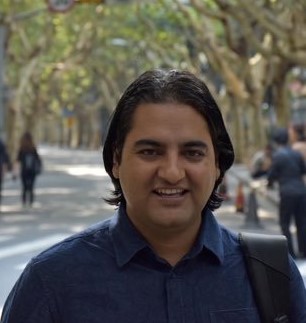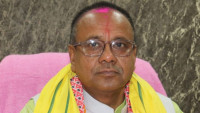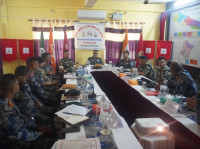Madhesh Province
Voters in Birgunj are perplexed as to who to vote for because of alliance politics
Since the Madhes Movement, the parties that championed it have splintered and ultimately joined hands with the forces they once rebelled against, puzzling voters.
Tufan Neupane & Bhusan Yadav
Seventy-year-old Shuvan Dewan of Nagwa Gaon in Birgunj Metropolitan City has been exercising franchise for 52 years. By his age and the experience of participating in elections over the years, he always considered himself a conscious voter.
He has been voting for Madhes-based parties every election since 2008, he says.
But he is confused now.
“The so-called big parties always undermined the Madhesis. And the parties that have their roots in Madhes have gone to join hands with them,” he said. “They promise one Madhes province of 22 districts, but they settle for eight. They promised Rs5 million for the kin of the martyrs of [political] movements but nothing happened. Now I wonder who to vote for and on what basis.”
Dewan’s disenchantment stems from the Madhes-based parties’ decision to align with those forces against which they were once fighting. Also, Madhes-based parties’ failure to stick together to fight for the Madhes cause has left him disappointed.
Currently, there are two recognised forces in Madhes Province—Janata Samajbadi Party and Loktantrik Samajbadi Party. Until August, they were one force, ultimately united having suffered several splits.
The Janata Samajbadi is under an alliance with the Nepali Congress, the CPN (Maoist Centre) and the CPN (Unified Socialist). The other force in the coalition, Rastriya Janamorcha, has negligible clout in Madhes.
The Loktantrik Samajbadi, on the other hand, has forged an alliance with the CPN-UML, whose leader KP Sharma Oli is largely viewed as an anti-Madhes politician.
Manoj Sah, who is a devoted worker of the Nepali Congress, is upset with the party leadership for not fielding a mayoral candidate for Birgunj Metropolitan City. Sah said his morals do not allow him to vote for a candidate who is not from his party.
As per an understanding among the coalition leaders, Janata Samajbadi’s Rajesh Man Singh and Imtiyaz Alam of the Congress are running for mayor and deputy mayor posts in Birgunj.
Vijay Sarawagi, who won the mayoral race in 2017 from the then Sanghiya Samajbadi Forum (now Janata Samajbadi Party), has switched to the UML, seeking a second term in office. Loktantrik Samajbadi’s Purushottam Jha is the deputy mayor candidate as per the party’s electoral understanding with the UML.
Sah says ideological lines in Nepali politics have been blurred, making it difficult for many loyal voters to decide who to vote for because of alliance politics.
Madhes is the second largest province in terms of the number of voters, with a total of 3,331,170 registered voters, according to the Election Commission.

Birgunj is a major business and industrial hub of Madhes. Bordering India, it is a politically significant city, a hotspot of the Madhes Movement. Birgunj is a microcosm of Madhes.
Birendra Sah, a lecturer of sociology at the Birgunj-based Thakur Ram Multiple Campus, said this is the first election since 2008 when the Madhes Movement is not in focus.
The 2007 Madhes Movement, spearheaded by the leaders of the two Madhes-based parties, largely contributed to the country’s adoption of a federal system.
“The movement made the people politically aware but the leaders used it as a tool to fulfil their petty interests,” said Sah. “Several issues remain unaddressed. Madhes-based parties, however, failed to remain united.”
According to Sah, there is no ideological base in any of the Madhes-based parties now and no party has any long-term plans.
“Party leaders are forming alliances with those forces which were their foes once,” Sah added. “Which party should the people choose? Whose agenda is correct? The voters in Madhes are confused.”
The Madhes-based parties in 2017 had even decided to boycott local elections because they had their objection to the constitution, which they and some other sections of the society said further marginalised the downtrodden. It was because of their protests that the 2017 local elections were held in three phases.
When Madhes-based parties were leading protests in the lead up to the constitution promulgation, they received an overwhelming support from the people of the entire region.
But over the years, observers say, Madhes-based parties joined hands with forces like the Congress, the Maoist Centre and the UML, who they once charged with writing an anti-Madhes constitution.
Sah, the lecturer, says parties have failed to make the voters understand why these local elections are being held.
“The parties have imposed candidates on the voters, giving them little room to make a choice,” Sah told the Post. “Those who have money and influence stand a better chance of winning even if they don’t have any agenda. How can democracy strengthen when voters are forced into elections in such a way?”
There are a total of 136 local units in the eight districts of Madhes Province, where Birgunj is the only metropolitan city. There are three sub-metropolitan cities, 73 (urban) municipalities and 59 rural municipalities.
Madhes-based parties held sway in the province during the 2017 elections, while the Congress had traditionally enjoyed clout in the region, with the UML not having much influence. The Madhesi parties this time are not only divided but have aligned with different forces.
In the 2017 local polls, the Janata Samajbadi and Loktantrik Samajbadi had won 26 and 25 local units in the province. The Congress had won 40 local units, the Maoist Centre 21 and the UML 18. The remaining six units were won by some fringe forces.
Chandra Kishore, a journalist and writer based in Birgunj, says the Madhesi people, Madhesi agenda and Madhesi parties should be understood differently.
“Even though the parties are divided, the agenda of the movement raised by the Madhesi people is still relevant,” Chandra Kishore told the Post. “The election result of 2017 was influenced by the current of the Madhes movement. Since the state was refusing to talk to dissenting forces, they wanted to take the movement forward through elections. But that’s not the case anymore. Hence, alliances were formed.”
Due to alliance politics, parties have been forced to support candidates from other parties.
“The coalition’s electoral alliance suddenly became strong largely because of the country’s internal politics, geopolitics and the alliance partners’ goal to increase the number of seats in the House of Representatives,” said Chandra Kishore.
The UML and the Maoist Centre had swept the 2017 national elections as they had fought under an alliance. The parties merged in May 2018, but the merger was invalidated in March last year. Then in August last year, the Madhav Nepal faction split from the UML to form the CPN (Unified Socialist).
The UML, however, continues to remain the largest party in the House of Representatives. The Congress, the Maoist Centre and the Unified Socialist now want to defeat the UML, hence they have decided to stick together and have roped in the Janata Samajbadi and Rastriya Janamorcha in the alliance too.
Chandra Kishore believes alliance politics has made three kinds of impacts on Madhes politics.
“It has put the brakes on the continuity of Congress-Madhes relations. Despite Birgunj and Janakpur being its strongholds, the party has decided to cede mayoral posts to the Janata Samajbadi,” he said. “While the UML seems to have significantly increased its base in Madhes, Madhes-based parties that emerged as encouraging forces riding on the Madhes movement are disintegrating.”




 16.12°C Kathmandu
16.12°C Kathmandu













